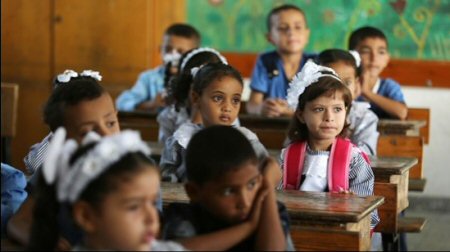On the occasion of International Literacy Day, the Palestinian Central Bureau of Statistics (PCBS) published a report, last week, on the illiteracy rate in Palestine ,and confirmed that it is one of the lowest in the world.
The report said that the illiteracy rate in 2017 was 3.3% (7,898 illiterate) in the occupied West Bank, East Jerusalem, and Gaza Strip refugee camps run by the United Nations Relief and Works Agency for Palestine Refugees (UNRWA), which currently faces a financial crisis following the United States’ decision, which may affect its educational programs, compared to 3.1% (67,324 illiterate) in urban areas, and 4.8% (20,228 illiterate) in rural localities.
According to the definition by the United Nations for Educational, Scientific and Cultural Organization (UNESCO), an illiterate person identifies as the one who is unable to read and write with understanding a simple statement related to one’s daily life.
UNESCO Institute for Statistics reported that the illiteracy rate among individuals of 15 years and above in Arab countries was 24.8% (about 64.6 million illiterate) in 2016. For males, 17.4% (23.7 million illiterate) compared to 32.8% for females (40.9 million illiterate).
For the same year, the rate was 13.8% (about 750.1 million illiterate) in the world among the same age group: for males, 10.2% (277.2 million illiterate) compared to 17.3% for females (472.9 million illiterate).
PCBS’s report further stated, according to Ma’an, that the illiteracy rates among the Palestinian population aged 15 years old and above, fell in the period between 1997 and 2017 from 13.9% to 3.3%. For males, the rate fell from 7.8% in 1997 to 1.7% in 2017, while for females it fell from 20.3% to 5.0% over the same period.
The report also said that 95,450 were illiterate in 2017 (1.7% for males, or 24,590 illiterate, compared to 5.0% for females, or 70,860 illiterate), and divided into 3.6% in the West Bank (62,736 illiterate) and 3.0% in Gaza Strip (32,714 illiterate).
The illiteracy rate among older persons aged 65 years and above was 34.6% (52,165 illiterate) in 2017. The rate was 4.5% in the 45-64 year age group (24,656 illiterate), 1.3% in the 30-44 year age group (10,068 illiterate) and 0.6% among young people aged between 15-29 years (8,561 illiterate) in the same year.
The illiteracy rate among rural localities in 2017 reached 4.8% (20,228 illiterate), while scored 3.3% in the refugee camps (7,898 illiterate) and 3.1% (67,324 illiterate) in urban areas. In 2017, the male illiteracy rate was highest in rural localities, followed by urban areas and refugee camps respectively. Female illiteracy rate was highest in rural localities, followed by refugee camps and urban areas respectively.
In 2017, the highest illiteracy rate among the Palestinian population aged 15 years and above was in Jericho and the Jordan Valley district, scoring 5.5% (1,623 illiterate), followed by Tubas and the Northern Valley district, scoring 4.7% (1,808 illiterate).
Additionally, the lowest rate was in the Jerusalem and Gaza districts with only 2.3% (5,752 illiterate in Jerusalem and 8,778 illiterate in Gaza).
Palestinian Prime Minister Rami Hamdallah, in response to the report by PCBS, urged support for UNRWA to help it continue with its educational programs for tens of thousands of Palestinian students.
Hamdallah said “We are proud that the illiteracy rate in Palestine in 2017 is among the lowest in the world.”
He pointed out that the Palestinian government implemented many education programs for adults and opened classrooms to combat illiteracy among the adult Palestinian population.
Hamdallah wrote a Facebook post regarding the program “We have launched the National Strategy for Adult Education, which is considered the first of its kind in the Arab world, in order to lower illiteracy and achieve the two goals of education for all and education for life.”
Human Interest 09/04/18 Show Jumping in Gaza: Riding Brings Hope (VIDEO)

